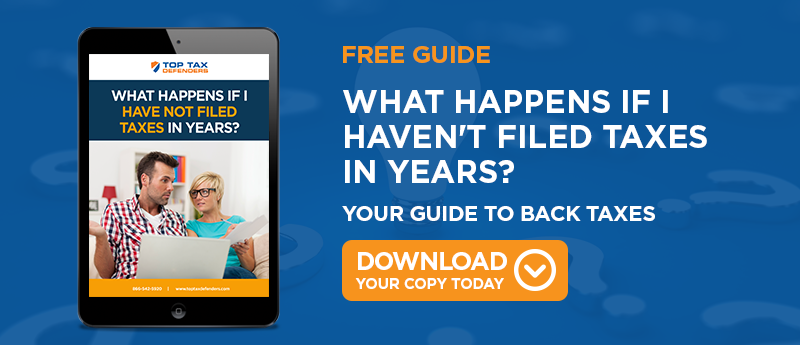
Do you owe back taxes? You have options for tax debt settlement that can help you get straight with the IRS. It’s no fun getting letters from the federal government that show your tax debt rising with every month that goes by.
To settle your debt, you need to take action as soon as possible. Read through this overview and see which solution works best for you. Most of the time, you can set up back tax repayments yourself.
What Are Back Taxes?
Back taxes are income taxes, property taxes, and other taxes that you have forgotten or neglected to pay or perhaps were unable to pay on time and in full. Falling behind on your taxes adds stress to your life and, unfortunately, continues to dig into your wallet until you take care of the problem.
They are also called delinquent or overdue taxes, typically from previous tax years.
Penalties for Back Taxes
When you don’t pay your taxes on time, the IRS charges a fee for late payment. The agency charges 0.5% of the tax balance for each month or part of a month the balance exists, topping out at 25%.
The penalties don’t stop there. Your unpaid tax balance also accrues interest at the federal short-term rate plus 3%. The short-term rate is determined (and can change) every three months. If you don’t pay your back taxes, the total amount you owe just keeps growing.
The 411 on Installment Plans
Here are a couple of details about installment plans you might want to know going in.
If you owe more than $25,000, the IRS requires you to make payments via automatic withdrawals from a bank account. Alternatively, you can pay with a credit card or debit card, but you are responsible for the processing fees.
- Debit card payment fees: $2 to $4 per payment
- Credit card payment fees: 2% of the payment amount
To qualify as a low-income taxpayer with eligibility for reduced fees, your income must be at or below 250% of the federal poverty level.
Ways to Settle Your Tax Debt
As you might expect from the discussion above, an installment plan is one way to settle your tax debt.
An installment plan is an agreement with the IRS allowing you to pay your back taxes monthly over time. Before rushing off to set this up, be sure you meet the eligibility requirements:
- You are up to date with filing tax returns.
- Your state income taxes and late fees are mostly paid.
- You can make the minimum monthly payment the IRS requires.
You make monthly payments at an amount you and the IRS agree you can pay. If you skip a payment or pay late, you might lose your installment agreement and wind up with wage garnishment or tax liens.
Short-Term Installment Agreement
A short-term installment agreement allows you to settle your back taxes within less than 120 days. Your maximum tax debt can be no more than $100,000 in combined taxes, interest, and penalties.
It’s free to apply online, by mail, or in person. You can pay your balance via:
- Direct pay - direct withdrawals from a checking or savings account
- E-pay online or by phone via the IRS Electronic Federal Tax Payment System (EFTPS)
- Check, money order, debit card, or credit card
A short-term installment agreement can minimize the amount of interest and penalties you accrue. Pay everything off in three months, and you're done.
The IRS also offers an extended short-term installment agreement. You apply by phone or mail and have up to 180 days to pay.
Long-Term Installment Agreement
A long-term installment agreement allows you to settle your back taxes within 120 days to 72 months (six years). Your maximum tax debt can be no more than $50,000 in combined taxes, penalties, and interest.
If you pay via automatic debit withdrawals, you pay the following fees:
- $31 setup fee to apply online
- $107 set fee to apply by phone, mail, or in person
The IRS may waive the setup fee for low-income taxpayers.
If you pay by some other method, like Direct Pay, EFTPS, or money order, you pay the following fees:
- $130 setup fee to apply online
- $225 setup fee to apply by phone, email, or in person
- $43 setup fee for low-income taxpayers, which may be reimbursed later
Offer in Compromise
An Offer in Compromise allows you to pay less than you owe in back taxes, either as a lump sum or in short-term installments.
Don’t get too excited, though. The IRS must believe you cannot pay any more than you offer or in any other way. The agency grants only a tiny percentage of offers in compromise it receives.
There is a non-refundable filing fee of $205 unless you qualify as a low-income taxpayer, in which case the fee is waived.
Next, you need to make an initial non-refundable payment of at least 20% of your offer amount if you agree to pay in five or fewer installments. Otherwise, you must pay the first monthly installment; then, your offer is accepted, and you pay the rest in six or more monthly installments for up to 24 months.
Partial Payment Installment Agreement
Under certain circumstances, the IRS agrees to take smaller payments spread over an extended time. The IRS has the right to review your finances during the repayment period.
If the agency finds that your financial situation has improved, your payment increases or the IRS begins taking other measures to collect on the original debt.
You must use all available assets to repay your debt before you can qualify for a partial payment installment agreement. Also, the IRS can ask you to use the equity in assets you own to pay off the balance, like a home equity line of credit.
Bottom Line
You messed up or couldn’t help it. You didn't pay your taxes, and now you owe back taxes. This overview for settling your back taxes can help you determine your next step. However, you need to move quickly before too much more interest and penalties accrue.
If you need help, contact Top Tax Defenders. We can explain all the details and help you make the best decision.




